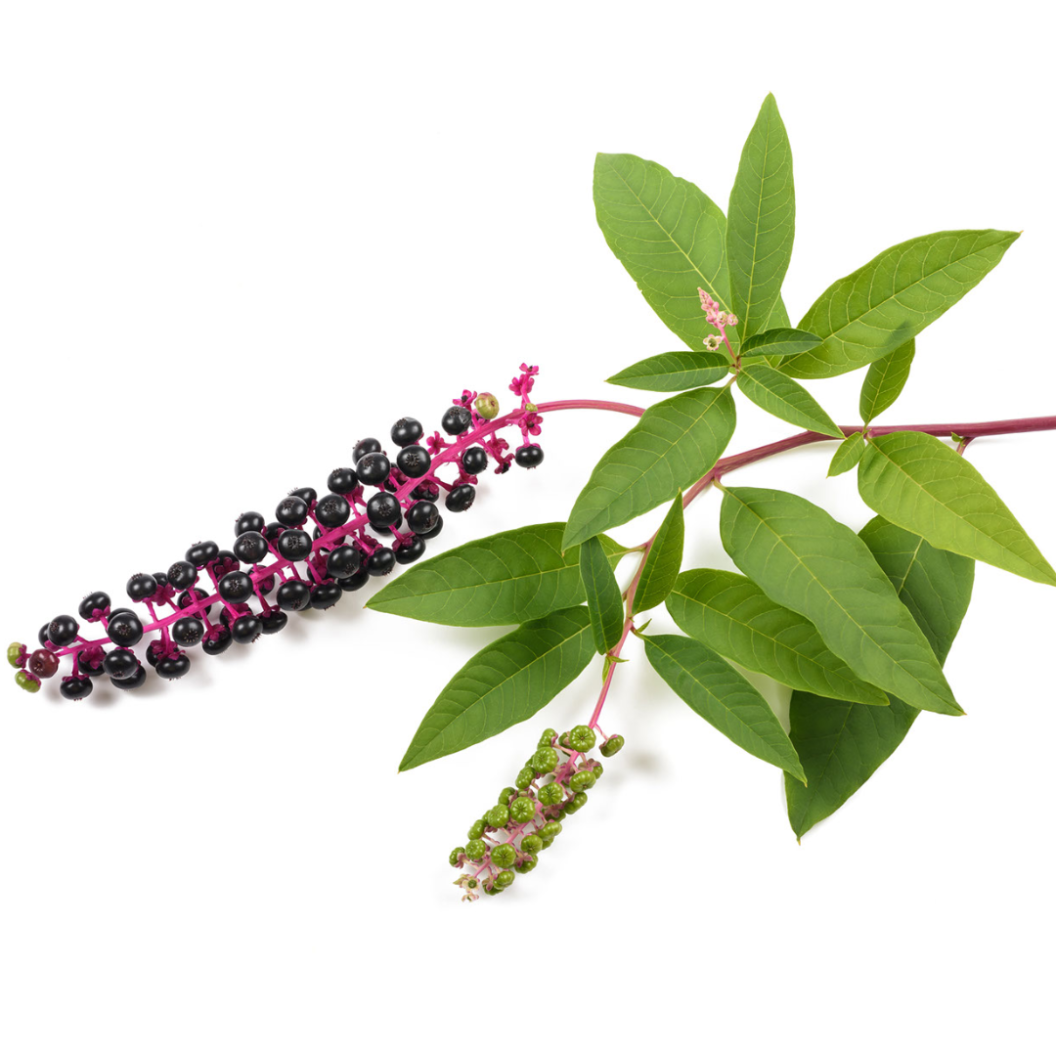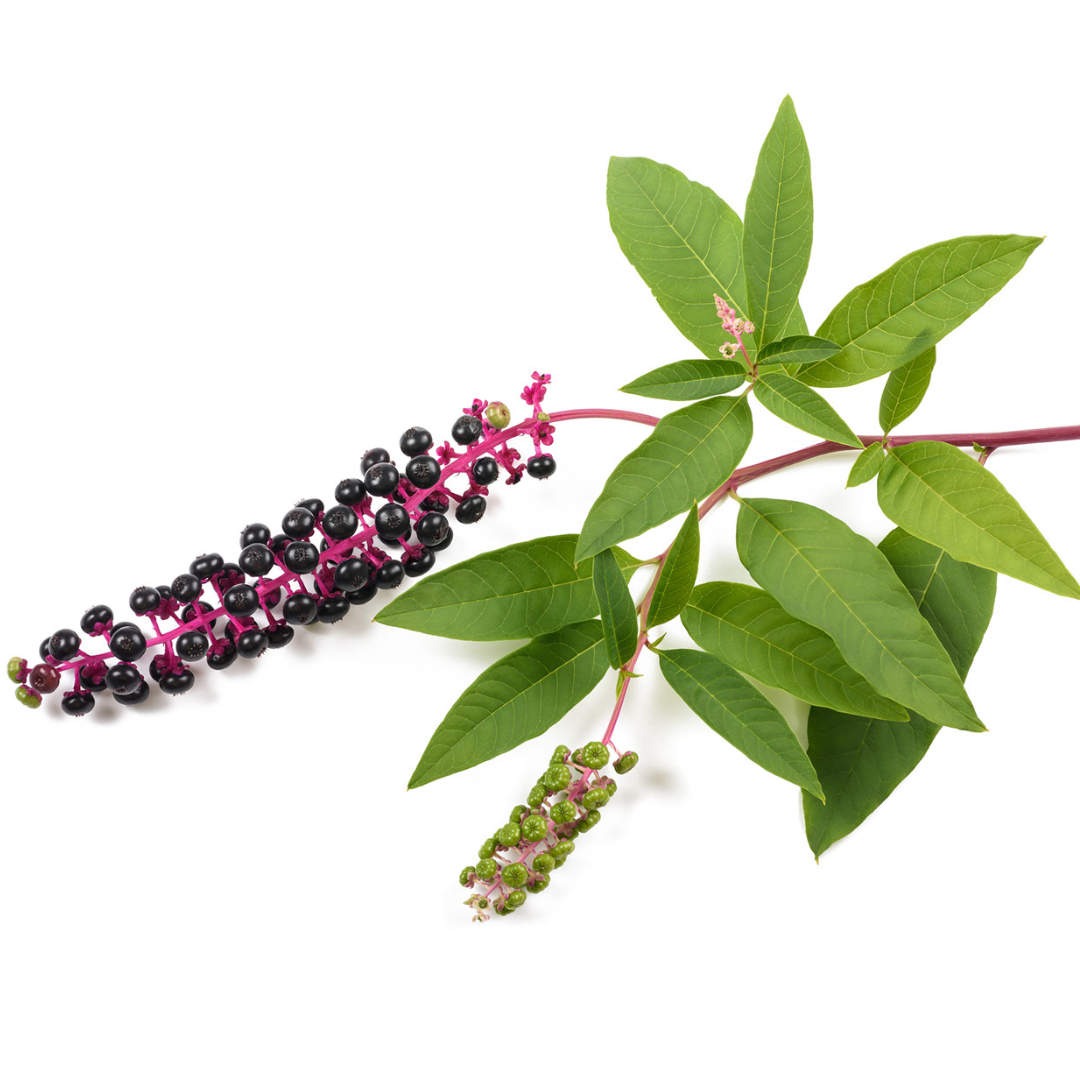
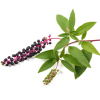
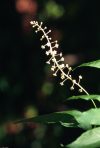


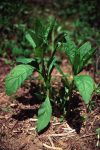
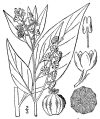
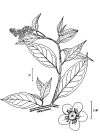
Pokeweed
DESCRIPTION: Pokeweed is a tall plant with big green leaves and pretty purple berries. It grows incredibly easily, hence it being considered a weed, and can get pretty large if not kept in check. Some people like to eat the leaves, but you have to cook them just right or they can be poisonous. The plant has been used in traditional medicine for a long time, and some people even use it as a natural dye for fabrics.
SCIENTIFIC NAME: Phytolacca americana
OTHER NAMES: Pokeberry, Poke Root, Inkberry, Pigeonberry
LEAF TYPE: Broadleaf
FLOWERS: The pokeweed's flowers are small and white, and they grow in long clusters that droop down from the plant. They kind of look like little bells, and they have a sweet fragrance that attracts bees and butterflies. When the flowers start to die off they turn into small green berries that eventually mature into the distinctive purple berries that this plant is known for.
LEAVES: Pokeweed's leaves are large and smooth, with a bright green color. They kind of look like the leaves on a grapevine, but they're bigger and more heart-shaped. The leaves grow alternately along the stem of the plant, and they can get pretty big - up to a foot or more in length! Some people like to eat the leaves when they're young and cooked just right, but you have to be careful because they can be poisonous if they're not prepared properly.
LIFE CYCLE: Perennial
HOW TO IDENTIFY: Pokeweed is pretty easy to identify! It's a tall plant with big green leaves that kind of look like grapevine leaves. As the plant matures, it develops clusters of small white flowers that turn into drooping clusters of purple berries. The berries are pretty distinctive - they're about the size of a pea and look almost like little grapes. When you touch the plant, the stems and leaves may release a milky white sap. Overall, if you see a tall plant with big green leaves and clusters of drooping purple berries, it's probably pokeweed!
MECHANICAL CONTROL RECOMMENDATIONS:
1. Hand pulling - More Info
2. Cutting - More Info
3. Mowing - More Info
4. Tilling - More Info
5. Repeated Disturbance - More Info
6. Mulching - More Info
7. Grazing Animals - More Info
CHEMISTRY RECOMMENDATIONS:
"Pre-emergent herbicides:
Prodiamine: This is a pre-emergent herbicide that's effective against a variety of annual grasses and broadleaf weeds. It might offer some control over germinating pokeweed seeds.
Oryzalin: Another pre-emergent herbicide with broad-spectrum activity. It's often used for controlling grassy and broadleaf weeds in various settings.
Pendimethalin: This herbicide is used to prevent the growth of a wide range of annual grasses and broadleaf weeds before they emerge.
Isoxaben: While isoxaben is primarily used for broadleaf weed control, it might have some effectiveness against germinating pokeweed seeds.
Post-emergent herbicides:
Glyphosate: Glyphosate is a non-selective herbicide commonly used to control a wide range of weeds, including perennial ones. It's best used when pokeweed is actively growing. Be cautious, as glyphosate is non-selective and will kill any plants it comes into contact with.
Triclopyr: Triclopyr is a selective herbicide that targets broadleaf plants and can be effective against woody plants like pokeweed. It's available in various formulations.
2,4-D: This is another selective herbicide effective against broadleaf plants. It might provide some control over pokeweed, especially when used in combination with other herbicides.
Dicamba: Dicamba is a selective herbicide used to control broadleaf weeds. Like other herbicides, its effectiveness against pokeweed might vary.
Clopyralid: Clopyralid is a selective herbicide often used to control broadleaf weeds, including certain woody plants. It might have some activity against pokeweed.
Selective herbicides:
Glyphosate: Glyphosate is a non-selective herbicide commonly used to control a wide range of weeds, including perennial ones. It's best used when pokeweed is actively growing. Be cautious, as glyphosate is non-selective and will kill any plants it comes into contact with.
Triclopyr: Triclopyr is a selective herbicide that targets broadleaf plants and can be effective against woody plants like pokeweed. It's available in various formulations.
2,4-D: This is another selective herbicide effective against broadleaf plants. It might provide some control over pokeweed, especially when used in combination with other herbicides.
Dicamba: Dicamba is a selective herbicide used to control broadleaf weeds. Like other herbicides, its effectiveness against pokeweed might vary.
Clopyralid: Clopyralid is a selective herbicide often used to control broadleaf weeds, including certain woody plants. It might have some activity against pokeweed.
Non-Selective herbicides:
Glyphosate: Glyphosate is one of the most widely used non-selective herbicides. It kills a wide range of plants by inhibiting a key enzyme involved in plant growth. It's available in various formulations, including ready-to-use sprays and concentrates.
Glufosinate: Glufosinate is another non-selective herbicide that works by disrupting plant metabolism. It's often used to control weeds and grasses in various settings.
Paraquat: Paraquat is a fast-acting non-selective herbicide that disrupts plant cell membranes and photosynthesis. It's highly toxic and requires careful handling.
Diquat: Diquat is a contact herbicide that affects plant cell membranes. It's often used for aquatic weed control but can also be used on terrestrial plants.
Imazapyr: Imazapyr is a non-selective herbicide that is particularly effective against perennial plants and woody species. It's often used for vegetation control in areas like rights-of-way and industrial sites.
Recommended Prevention
Recommended Control

